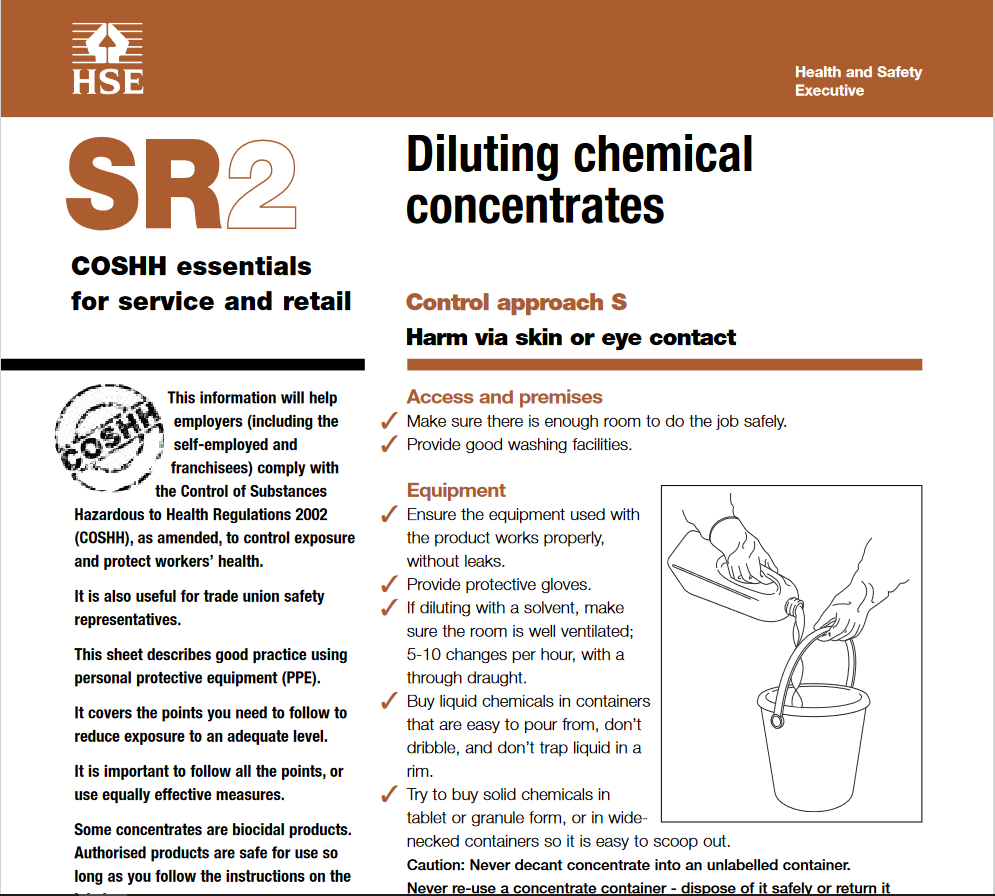Overview of COSHH and Safety Symbols
Safety Data Sheets
Safety Data Sheets (SDS) are required by the UK REACH Regulation, and are an integral part of your business’s Control of Substances Hazardous to Health (COSHH) assessments. The SDS itself is not a COSHH assessment, but it does provide important information regarding any hazards associated with a particular product. This allows employers to assess workplace hazards, and create an appropriate COSHH assessment to ensure materials are used without risk of harm to users or the environment.
Control of Substances Hazardous to Health Regulations (COSHH)
COSHH is a set of regulations that ensure the health of people using certain substances are protected from any negative health effects that could arise from working with the substance. It is a legal requirement for an employer to control exposure to such materials, and for both employers and employees to adhere to the controls, such as PPE and working practices, in place.
Many materials you encounter in day to day life can potentially damage health if used incorrectly, for example washing up liquid, or laundry detergents, can be very damaging to eyes and have serious effects if ingested. However, people use these products regularly, without issues, despite the potential dangers. With the correct procedures, and understanding, any material can be handled and used safely with the appropriate working practices.
The Safety Data Sheet allows employers to make an informed decision about how a material could affect users and the environment. Combined with knowledge of the task being performed, and the environment in which it is being carried out, this allows the assessor to create a COSHH risk assessment (and associated procedures) for the safe use of the material in question.
Dilution of Products
An SDS is for the material as supplied and is not directly applicable to the diluted product, which will generally be of a lower hazard classification. For example, washing up liquid is usually classed as an irritant in its neat form, and gloves would be recommended to avoid skin irritation. But when diluted for washing up purposes it would not be classed as an irritant, and whether to wear gloves would be a choice for the end user, rather than a requirement.
There is no simple rule regarding hazards and dilutions, please feel free to contact us for advice and we will be happy to help.
Further Resources
The Health and Safety Executive (HSE), Britain's national regulator for workplace health and safety, has a number of useful documents providing the basic information needed to adhere to COSHH and related regulations. In addition to being a legal requirement for a business, a good understanding of the health and safety requirements around COSHH will result in a safe and healthy workplace for staff, customers, visitors, and any other parties you work with.
If you need any assistance, or can’t find the SDS you require, please message us at info@skychemicals.co.uk and we will be happy to help.
Guide to Safety Symbols
The warning symbols used on products conform to the Globally Harmonized System of Classification and Labelling of Chemicals (GHS) standard. GHS is an internationally agreed system allowing for the same symbols to be used around the world, avoiding confusion generated by different labelling systems.
The following is a list of the hazard symbols you may find on safety data sheets, and a brief overview of the hazard.
Included for completeness, none of our products are classified as explosives.
The explosion pictogram appears on the chemical labels of substances that are:
Explosives - which is a solid or liquid chemical capable of a chemical reaction that causes damage to the surroundings,
Self-Reactive - heating may cause fire or explosion without the need for air, or
Organic peroxides - again, heating may cause fire or explosion.
e.g. azides, trinitrotoluene, nitroglycerine, azidoazide azide
GHS01:
Explosive
GHS02:
Flammable
Flammable: Flame Symbol
Appears on chemical labels for substances that are:
Flammables - gases, aerosols, and combustible liquids or solids that will burn or ignite under certain conditions
Self-Reactives - heating alone, without air, may cause fire or explosion
Pyrophoric substances - in small amounts, may ignite within 5 minutes after contact with air
Self-Heating - may catch fire when exposed to air
Water reactive substances that release flammable gas when wet
Some organic peroxides - which, when above a critical temperature, may cause fire or explosion; may be sensitive to impact or friction; and may react dangerously with other chemicals
e.g. Organic solvents and vapours (such as acetone, methanol, ethanol, propanol, etc.)
GHS03:
Oxidising
Oxidising: Flame over Big Letter ‘O’ Symbol
This symbol on a chemical label means that the substance is an oxidiser. Oxidisers may cause a fire by increasing the concentration of oxygen in the air.
e.g. sulphur dioxide, chlorine, potassium permanganate, nitric acid, hydrogen peroxide
GHS04:
Compressed Gas
Compressed Gas: Gas cylinder symbol
This pictogram on a chemical label means that the substance is a compressed, liquefied, or dissolved gas under pressure at 29 pounds per square inch or more.
e.g. compressed gases (such as nitrogen and air cylinders), liquified cryogenic gases (such as liquid argon), and dissolved gases under pressure (such as acetylene).
In addition to any other hazards, compressed gases will usually present an asphyxiation risk in confined spaces if the gas leaks.
GHS05:
Corrosive
Corrosive: Liquid eating into surface and hand symbols
This pictogram on a chemical label means that the substance is corrosive to some materials.
causes serious damage to skin and / or eyes
corrosive to some metals
e.g. strong acids (such as sulphuric acid), strong bases (such as sodium hydroxide)
Corrosive substances includes both acids and bases. Care should be taken to NEVER mix acids and bases as they can generate a lot of heat and possible side reactions, making mixing of acids and bases potentially very dangerous.
GHS06:
Toxic
Toxic: Skull and crossbones symbol
Substances with a hazard of acute toxicity will have this symbol on their chemical label. Acute toxicity means that exposure to a single dose of the chemical may be toxic or fatal if inhaled or swallowed, or if it comes into contact with the skin.
GHS07:
Harmful
Harmful: Exclamation mark symbol
It is used on a chemical label for substances that represent the following hazards:
Irritant - irritates the skin or eyes;
Skin sensitiser - an allergic response following skin contact;
Acute toxicity - which may be fatal or cause organ damage from a single short-term exposure;
Narcotic effects like drowsiness, lack of coordination, and dizziness
Respiratory tract irritation.
GHS08:
Health Hazard
Health Hazard: Upper body image showing ‘Systemic Effects’
Specific Target Organ Toxicity / Chronic Health Hazards
This pictogram is put on a chemical label when a substance presents these health hazards:
Carcinogen - may cause cancer
Respiratory sensitizer - may cause respiratory irritation
Reproductive toxicity - may damage fertility or the unborn child
Target organ toxicity - may cause damage to bodily organs by single or repeated exposure
Mutagenicity - may cause genetic defects
Aspiration hazard - may be fatal if swallowed and enters the airways
e.g. Chromium (VI) compounds
GHS09:
Environmental Hazard
Environmental Hazard: Dead tree and fish symbol
Toxic / Harmful to the environment, in particular to aquatic environments and organisms.
e.g. Sodium hypochlorite (bleach)











